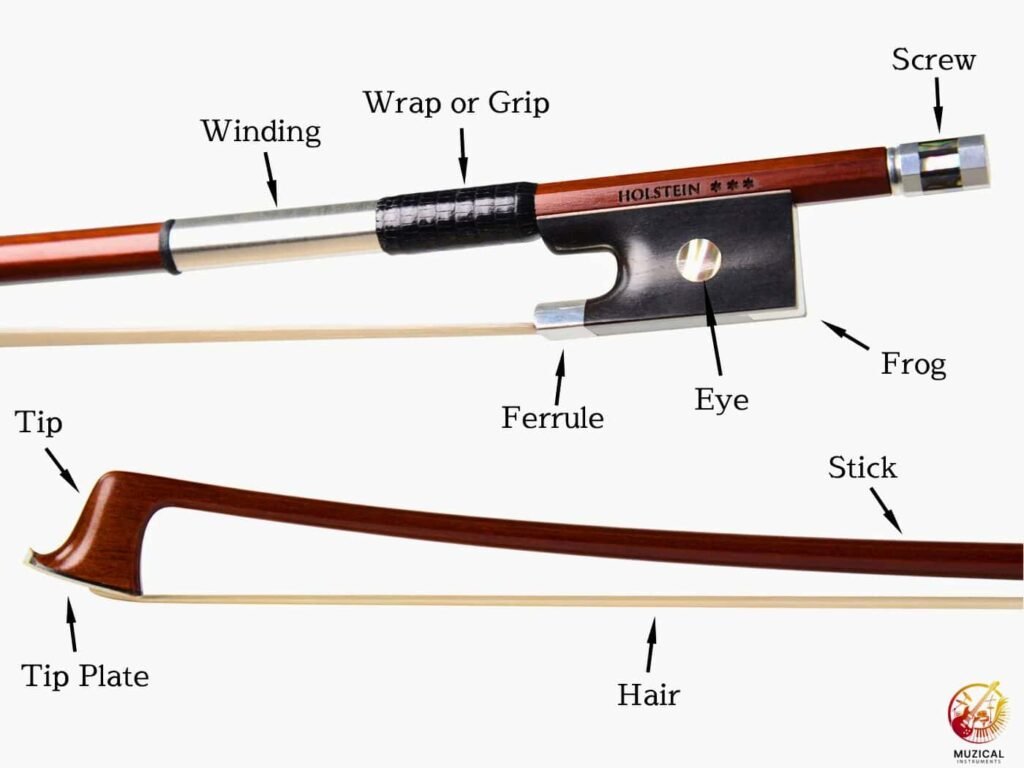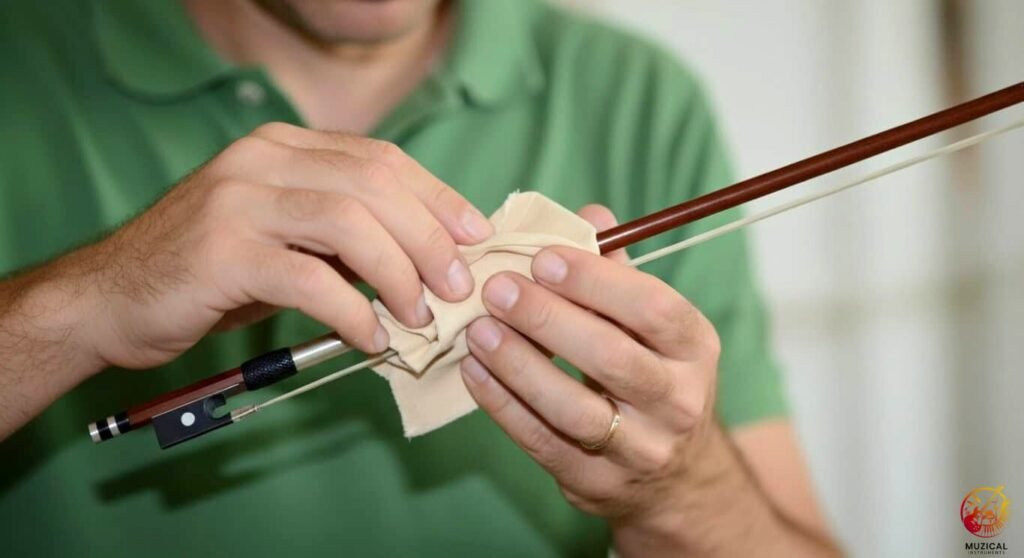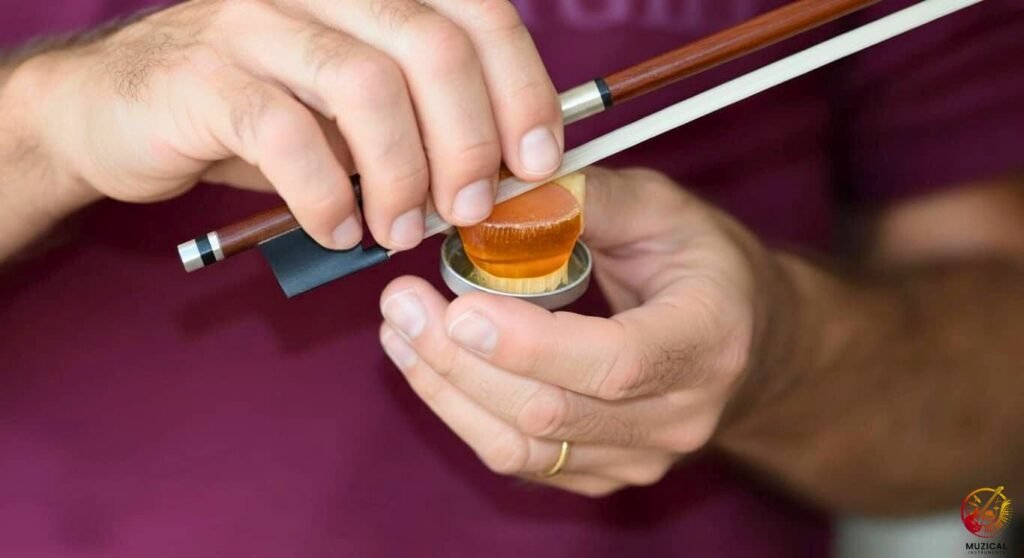Beginner’s Guide to Violin Bow Maintenance and Care
Violin bow maintenance affects 50% of your sound quality, yet most beginners focus entirely on the instrument itself. Your bow creates the actual sound you hear, the violin just amplifies it. Without proper bow care, even a $10,000 violin sounds scratchy and weak.
In this guide you will learn exactly what to do daily, what to do weekly, and when to run to a luthier (a violin expert). Let’s get your violin bow care sorted out.
What is the Bow? A Quick Look
So many players focus on the violin, but the bow is 50% of your sound. It’s not just “a stick with hair.” It’s a sensitive tool. If you don’t know the parts, you can’t take care of it.

The Four Parts You Must Know
- The Stick: This is the main body of the bow. It’s built with a specific curve (called a camber) to create the right tension and bounce.
- The Bow Hair: This is almost always horsehair. This is the part that touches the strings. It’s not smooth; it has tiny ‘scales’ that grip the string.
- The Frog: This is the black part (usually ebony) that you hold. It houses the mechanism that tightens and loosens the hair.
- The Screw (or Tensioner): The button at the very end of the bow. You turn this to pull the frog back, which tightens the hair.
Your Violin Bow Maintenance Toolkit
You don’t need much. Here’s the complete list.
| Item | What It’s For | Why You Need It |
|---|---|---|
| Microfiber Cloth | Wiping rosin dust off the stick and violin. | Prevents rosin build-up. Safe for the varnish. |
| Rosin Cake | Gripping the strings. | Creates the friction needed to make sound. |
| Violin Case | Safe storage. | Protects from humidity, temperature, and accidents. |
| A Luthier’s Phone # | Repairs, re-hairing, and expert advice. | This is your “violin doctor.” Find a good one. |
Your Daily 2-Minute Bow Care Routine
This isn’t optional. This is what separates a good student from one with broken gear. It takes two minutes. Do it every single time you play.
Rule #1: Always Loosen the Bow Hair
This is the most important rule. When you finish playing, turn the screw to the left (loosen) until the hair is slack. The hair should be loose, but not dangling and messy.
Rule #2: Wiping Down the Stick
After you play, your bow stick (especially near the frog) will be covered in white rosin dust. Your fingers also leave oils on the wood. Take a soft, dry, lint-free microfiber cloth and gently wipe this gunk off.
Rule #3: Wipe the hair
Gently wipe the horsehair with a clean cloth to remove rosin dust. Avoid using alcohol on the hair itself.
Your Weekly 10-Minute Violin Bow Maintenance

Once a week, take a closer look. This is how you spot problems before they become expensive.
Checking the Screw (The Tensioner)
Does the screw turn smoothly? It should be easy to turn, not stiff or “grindy.” If it’s hard to turn, a little graphite (pencil lead) can sometimes help, but it’s better to ask your teacher or a luthier. Don’t force it.
Inspecting the Bow Hair for Damage
Look at the hair.
- Are you losing a lot of hairs on one side? This could mean your bow hold is crooked.
- Is the hair a gross, gray color near the frog? That’s from your fingers. (Stop touching it!)
- Are there a lot of broken hairs? It’s normal to break a few. It’s not normal to break 5-10 every time you play.
Checking the Stick for Warping
Here’s how to check for a warp:
- Tighten the bow to playing tension.
- Hold it up and look down the length of the stick, from the frog to the tip.
- Does the stick curve to the left or right? It should be perfectly straight (long-ways). If it’s bending to the side, it’s warped. A warp is a serious problem that needs a professional.
How Do I Rosin a Violin Bow Correctly?

Rosin is the secret sauce. Without it, you get no sound. But most beginners get this all wrong.
What is Rosin and Why Do You Need It?
Rosin is just hardened tree sap. When you rub it on the bow hair, the friction creates a fine, sticky powder. This powder “grabs” the violin string, making it vibrate. No rosin = no grip. No grip = no sound. The bow just slides.
A Step-by-Step Guide to Rosining
- Tighten the bow hair first. You want it at playing tension (about a pencil’s width between the stick and hair in the middle).
- Score the rosin (if it’s new). A new cake of rosin is glassy-smooth. The hair won’t grab it. Take a key or sandpaper and lightly scratch the surface to rough it up.
- Apply the rosin. Hold the rosin in one hand and the bow in the other. Gently slide the bow hair across the rosin, from the frog to the tip and back.
- Use 3-4 full swipes. That’s it. Beginners always use too much.
How often should you rosin your bow?
Not every day. You only need to rosin the bow when it needs it. When does it need it? When it stops “gripping” the string. If you practice 30-60 minutes a day, you might only need to rosin every 2-3 days. You’ll learn the feel.
When Is It Time for a Violin Bow Rehair?
You can’t use the same hair forever. It wears out. Getting a “rehair” means a professional luthier removes all the old hair and puts new, fresh horsehair in.
What is a rehair, exactly?
A luthier (a violin repair expert) carefully takes the frog and tip apart. They remove the old, stretched out hair. They measure and tie a new, fresh hank of horsehair. Then they fit it perfectly into the bow, checking the length and tension. It’s a very skilled job.
4 Signs You Need a Rehair
- Lots of Broken Hairs: If you’ve lost 15-20% of your hair (or it’s all broken on one side), the tension will be uneven. Time for a rehair.
- The Hair Won’t Hold Rosin: You rosin it, and 10 minutes later, it feels slippery again. The “scales” on the hair are worn down.
- The Hair is Stretched Out: You turn the screw, but the hair never gets tight. It’s stretched past its limit. This happens from humidity or just old age.
- It’s Just Dirty: The hair is dark gray or black near the frog, even if you never touched it. It’s full of old rosin and dust.
How often do you need a violin bow rehair?
This is a key part of long term violin bow care.
- Serious Students/Pros: Every 6-12 months.
- Beginners: Every 1-3 years, if you take good care of it. You’ll get a rehair because the hair is dirty or stretched, not just because it’s old.
How to Store Your Violin Bow Safely
This is easy to get right.
In the Case: The Right Way
Your violin case was designed to hold your bow. There are two clips in the lid. These are your bow holders.
- Loosen the bow hair. (You did this already, right?)
- Place the frog in the wider, U-shaped holder.
- Place the tip in the other holder.
- Turn the little spinner (or “latch”) to lock it in place. Now it’s secure. It won’t rattle around and scratch your violin.
Can I leave my violin bow out of the case?
No. A bow left on a music stand will be knocked over. A bow left on a chair will be sat on. A bow left on a table will roll off. A bow left out is also exposed to changes in humidity, which is a major enemy.
What About Humidity and Temperature?
Bows hate extremes.
- High Humidity (Summer): The wood swells, and the horsehair stretches. You might find you can’t tighten the bow enough.
- Low Humidity (Winter): The wood and hair shrink. The hair can become brittle and snap. The stick can even crack.
The fix? Store your bow in its case. The case acts as a buffer. In winter, you can use a small violin humidifier inside the case to keep things stable.
Quick Troubleshooting Guide
Here are the 3 most common problems I hear.
Bow Troubleshooting for Beginners
| The Problem | The Likely Cause | How You Fix It |
|---|---|---|
| “My bow is making a scratchy/raspy sound!” |
1. Too much rosin. 2. Too much bow pressure. |
1. Stop rosining for a week. 2. Relax your hand. Use less weight. |
| “My bow is making no sound (or a whisper)!” |
1. Not enough rosin. 2. You touched the hair. |
1. Apply 3–4 swipes of rosin. 2. You may need a rehair. |
| “My bow bounces when I don’t want it to!” |
1. Bow is too tight. 2. You are holding it too stiffly. |
1. Loosen the hair slightly. 2. Relax your thumb and pinky. |
Common Beginner Violin Bow Mistakes (and How to Fix Them)
I see these every day. Let’s make a list.
Mistake 1: Forgetting to Loosen the Hair (The #1 Sin)
- Problem: Warps the stick, kills the bow.
- Fix: Put a sticky note on your case: “Did you loosen your bow?”
Mistake 2: Touching the Horsehair
- Problem: Creates oily “dead spots.”
- Fix: Practice picking up the bow by the frog only. Never touch the hair. Ever.
Mistake 3: Over-Rosining
- Problem: Creates a scratchy, gross sound and a huge mess.
- Fix: 3-4 swipes. That’s it. Only rosin when it slips.
Mistake 4: Over-Tightening the Bow
- Problem: Puts too much stress on the stick. Beginners think “tighter is better.” It’s not.
- Fix: The “Pencil Test.” The gap between the hair and the stick (in the middle) should be about the width of a regular pencil. Any tighter is too tight. The stick should keep its gentle curve.
Mistake 5: Storing the Bow Incorrectly
- Problem: Leaving it on a music stand, on a chair, or just loose in the case.
- Fix: The bow has its own special holders (spinners or clips) in the case. Use them. Every time.
Final Thoughts: Your Bow Is Half Your Instrument
Your violin bow maintenance routine is simple, but it’s not optional. The bow is a sensitive tool, not a toy. If you remember just two things, make them these:
- Loosen the hair after every single practice.
- Never touch the hair with your fingers. Do these two things, and you’ll avoid 90% of all beginner bow problems. Keep it clean, keep it safe in its case, and it will serve you well for years.
FAQ: Violin Bow Maintenance and Care
1. What is the most important rule of violin bow care?
The number one rule is to always loosen the hair when you are done playing. Turn the screw at the end (to the left) until the hair is slack and soft. Leaving the bow tight is like pulling a rubber band for days, it will stretch the hair and, even worse, permanently warp the wooden stick.
2. How tight should my violin bow be?
When you tighten the bow to play, there should be a small gap between the hair and the stick. A good guide is the “pencil test.” The space in the middle of the bow (where it curves in) should be about the width of a normal pencil. You want the stick to keep its gentle curve, not become straight or bowed backward.
3. How often should I rosin my bow?
Not as often as you think! You only need to apply rosin when the bow stops “gripping” the string. If your sound becomes weak or “whispery,” it’s time. For most beginners practicing 30-60 minutes a day, this might only be once every 2-3 days. Just 3-4 slow swipes from end to end is enough.
4. Can I clean my violin bow hair?
It’s best if you don’t. The hair is very easy to damage. The main reason hair gets dirty is from oils on your fingers (so don’t touch it!). If you try to clean it with water or chemicals, you can ruin the hair and the bow’s wood. If the hair is truly black and sticky, it’s time to get it replaced by a professional (this is called a “rehair”).
5. How do I know if my bow needs a rehair?
You’ll know it’s time for a rehair (new hair) when a few things happen:
You’ve broken a lot of hairs, especially on one side.
The hair looks dark, greasy, and dirty (and won’t hold rosin).
The hair has stretched out so much that you can’t tighten it anymore.
For a student, this might be needed every 1-3 years.
